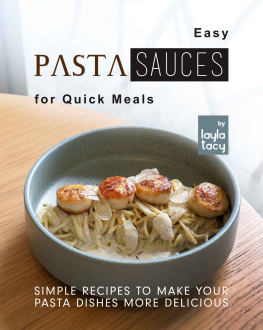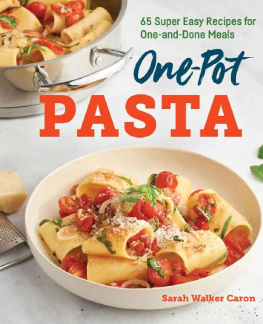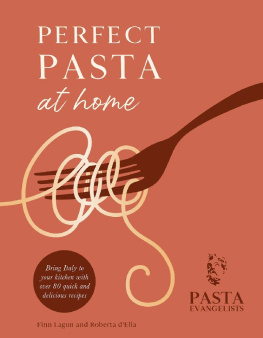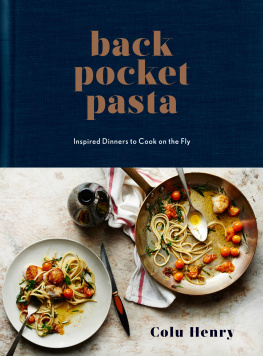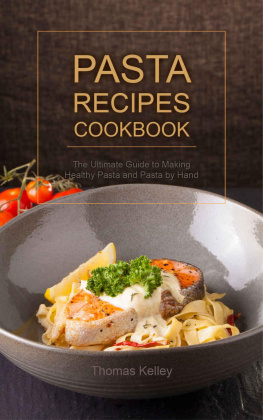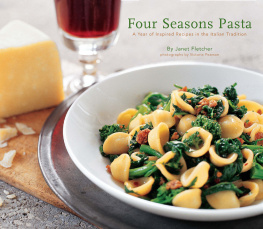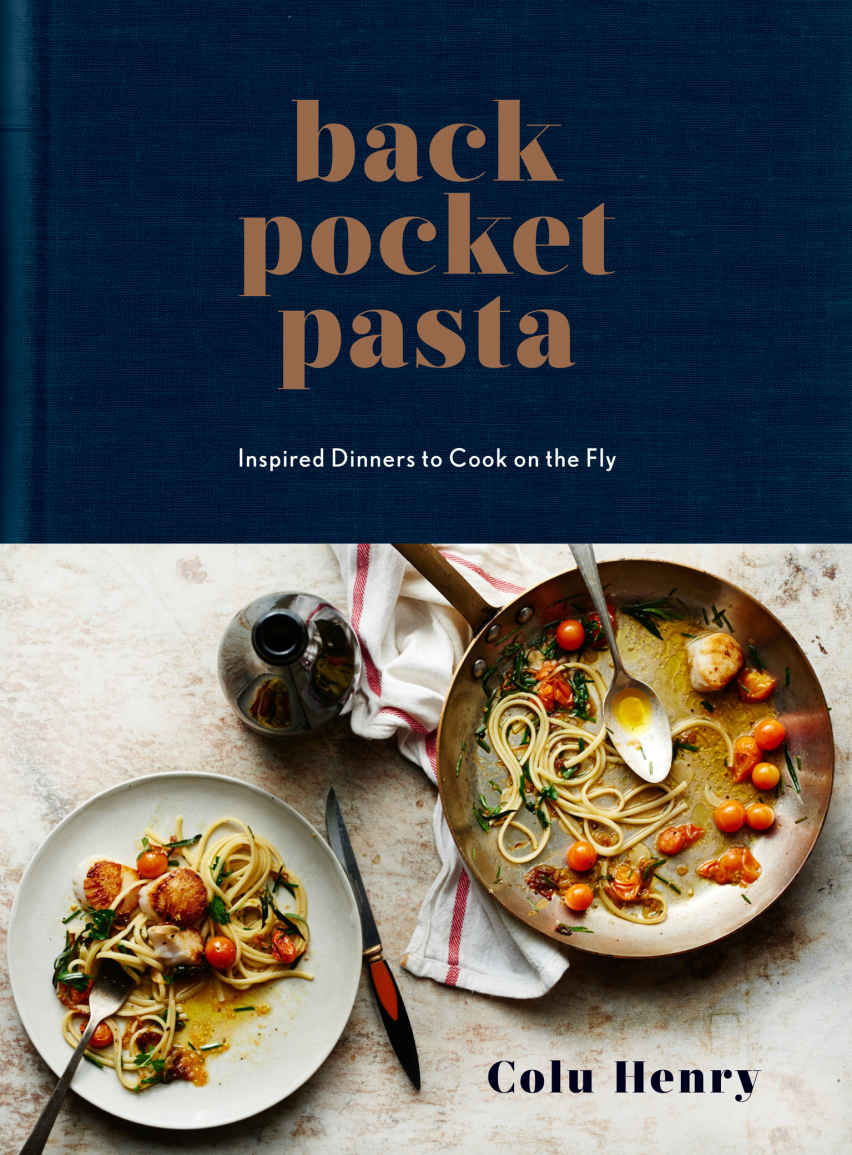Copyright 2017 by Colu Henry
Photographs copyright 2017 by
Peden + Munk
All rights reserved.
Published in the United States by
Clarkson Potter/Publishers, an imprint
of the Crown Publishing Group, a
division of Penguin Random House
LLC, New York.
crownpublishing.com
clarksonpotter.com
CLARKSON POTTER is a trademark
and POTTER with colophon is a
registered trademark of Penguin
Random House LLC.
Library of Congress Cataloging-in
Publication Data is available upon
request.
ISBN9780553459746
Ebook ISBN9780553459753
Cover design by Jennifer K. Beal Davis
Cover and interior photographs by Peden + Munk
v4.1
prh
For my mama,
MIA FERRARA HENRY,
for telling me I think I can.
I did.
contents
FROM TEORA TO THE TENEMENTS
BRIGHT LIGHTS, FAST DINNERS
FARM VISITS AND MARKET MEALS
ON THE ROAD AT HOME
introduction
We all tend to get hung up on recipes, but long lists of ingredients and steps arent actually that helpful for weeknight cooking. Everyone should be able to reach for whats closest and pull together something nourishing and beautiful without fuss. Whats most beneficial is to set up your pantry, stock your fridge, and open your eyes to what works well together. Simple, high-quality ingredients allow you to cut your hardworking self a break and, most important, have fun while doing so.
When I worked in food publishing and public relations, one might have believed that all I did was eat out (I did, quite a bit), but the truth was, when I wasnt dining out, I was coming home weary from work (like most of us) and just wanted an easy dinner that I didnt have to shop for. Something soulful but simple that, with a bottle of wine, could take the rest of the day away.
I started pulling together dishes with the thing I know bestpastaand using whatever items I had lying about. I would put the pot of water on to boil and in the meantime, rummage through my cupboards cobbling a dish together. I'd saut garlic and red pepper flakes, melt anchovies into olive oil, toss in leftover greens to wilt, and chop and toast whatever nuts I had for a topping. Before I knew it, we were sitting down for dinner. Eager to share my creations with friends to help them get out of their own weeknight rut, I started posting photos online, tagging them #backpocketpasta. Post-work cooking suddenly went from daunting to delightful.
I am the great-granddaughter of Italian immigrants. Maria-Nicolamy namesake, who also went by the name Coluand my great-grandfather Pietro emigrated from Italy. They hailed from a small village called Teora in the province of Avellino in southern Italy. Seventeen years old at the time of their crossing, they, like millions of other immigrants, arrived in this country with nothing. My nonni, Immacolata Ferrarawho went by Molly for shortwas the eldest of their seven children (only five survived) and was born here in 1909. She lived until she was 102 and recounted in our discussions that with many mouths to feed, Colus recipes were born out of poverty and necessity. She would cook with whatever ingredients she happened to have on hand, and with whatever was available at the market, but always took great care with her meals. Most of my great-grandmothers recipes were passed down verbally to my nonni and then from my nonni to my mother, Mia, and her brothers, Michael and John. As a child, I would listen to the stories that surrounded these recipestales that still excite me just as much as actually assembling the dishes themselves.
Growing up, we ate pasta two or three times a week. Marinara and tuna-clam sauce were in constant rotation, but Sundays were the best days. I would wake up to the smell of meatballs frying in olive oil and sauce simmering on the stove. Sometimes there was a lone pork chop that needed a home, and if we were extra lucky, wed also have braciole with pine nuts and raisins to look forward to. Sleepily, I would throw off my covers and rush downstairs for a plate of sauce, a meatball, and lots of grated Pecorino Romano. If Mama had a semolina sesame loaf from Arthur Avenue on hand, even better. Breakfast was served.
Sundays meat sauce is only one of many culinary traditions that we celebrated as a family. There was the Feast of the Seven Fishes on Christmas Eve (my personal favorite), minestra and pizza rustica on Easter Sunday, and countless others. And although my family has tweaked the recipes here and there over the years, we still use many of my great-grandmothers and nonnis scribbled notes to guide us in the kitchen.
These days my husband, Chad, and I split our time between Brooklyn and Hudson, New York, with our spaniel rescue mutt, Joshie, and we also travel as much as we can. The pastas I cook are always at the mercy of the pantries to which I have access. For instance, what I make Chad for dinner after a ten-hour workday is different from what I create when Im visiting my mom for the weekend or what we prepare for a traditional holiday at my uncle Michaels. That said, all the recipes Ive included in this book are inspired by the same principle. If you have a well-stocked pantry and shop somewhat seasonally, a back pocket pasta is never more than a pot of boiling water away.
heres how it works
Back Pocket Pasta is less a cookbook and more a loose guide and inspiration for making weeknight dinners artfully and on the fly. My hope is that this book will give you ideas and recipes on how to create your own back pocket pastas with just a few ingredients on hand. No two pantries are the same, so you should feel free to play around with ingredients. If you like extra heat, add more chiles. If you prefer broccoli rabe to Brussels sprouts, swap them out. Pancetta or prosciutto? You choose. Cooking is already more fun, isnt it?
PASTA DON'T PREACH
While Im a pretty laid-back cook, there are a few things I always do:
Salt the water well. Well-seasoned water is key to pasta perfection, so I add about 2 tablespoons (or two small palmfuls) of kosher salt to every large stockpot of boiling water.
Cook the pasta al dente. I generally follow the rules of whats on the pasta box as they provide cooking times for pastas to maintain its to-the-bite texture (very important). I also often taste the pasta a minute or so before its supposed to be done, just to ensure its not overcooking. You dont want soggy pasta.



